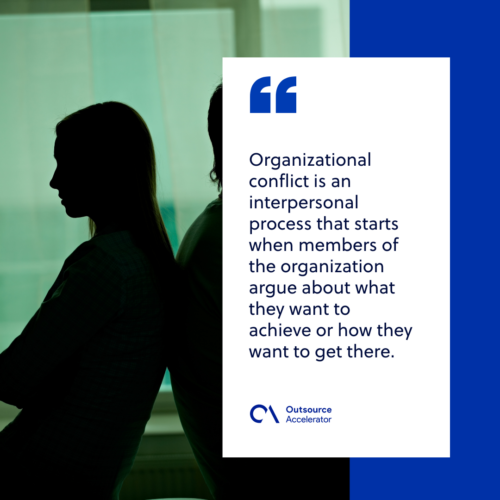Organizational Conflict
Definition
What is organizational conflict?
Organizational conflict is an interpersonal process that starts when members of the organization argue about what they want to achieve or how they want to get there. When two or more people interact at work, conflict occurs when their perspectives on a task or a decision differ.
Organizational conflict has the potential to be both constructive and destructive. The distinction is made based on how the disagreement is handled.
It is impossible to avoid conflict in all circumstances. Working through conflict can lead to a variety of positive consequences.
A properly managed conflict can help create positive change within an organization.

What are the types of organizational conflict?
Conflict arises from various factors: task, roles, process, organizational culture, external pressure, and interpersonal concerns.
The following are the most typical types of corporate conflicts:
Task or goal conflict
Task conflict is related to the work’s content and goal. When one person or group wishes a different conclusion than the others, goal conflict can arise. It is essentially a battle over who will pursue whose objectives.
Cognitive conflict
When one individual or a group of people has ideas or attitudes that are incompatible with others, cognitive conflict arises.
Role conflict
Role and duties conflicts are prevalent during or immediately after the organizational change, particularly restructurings. People may be unsure who is accountable for which processes and planning.
Affective conflict
When one person’s or a group’s feelings or emotions are incompatible with others, this form of conflict arises. Affective conflict occurs when two people are just unable to communicate with one another.
Conflict in behavior
When one individual or group does something that others find unpleasant, behavioral conflict arises. Using vulgar language and dressing for work in a way that “offends” others are instances of behavioral variance.
Conflict in the process
It has to do with how the work is completed. The process, actions, or tactics utilized to achieve a goal focus on this type of conflict. Some people prefer to plan out their moves in advance, while others prefer to jump right in.
Directional conflict
When organizations are compelled to reassess their strategies and focus on shorter-term initiatives, as many were during the economic slump, directional conflict occurs.
Employees may not understand how to prioritize long-term and short-term needs. It can also be one department may operate tactically while another operates strategically.
External conflict
When customers or other stakeholders exert pressure on internal choices, external conflict emerges. For example, customer service representatives pushing for clients’ requirements may have clashed with operations workers attempting to fulfill internal objectives.
Conflict in relationships
It is mainly concerned with interpersonal relationships. They are direct interactions between people, and they can be over roles, resources, or even personalities.
This type of organizational conflict has the potential to harm every area of an organization. Fighting in a relationship can quickly consume all of your attention and energy.







 Independent
Independent




